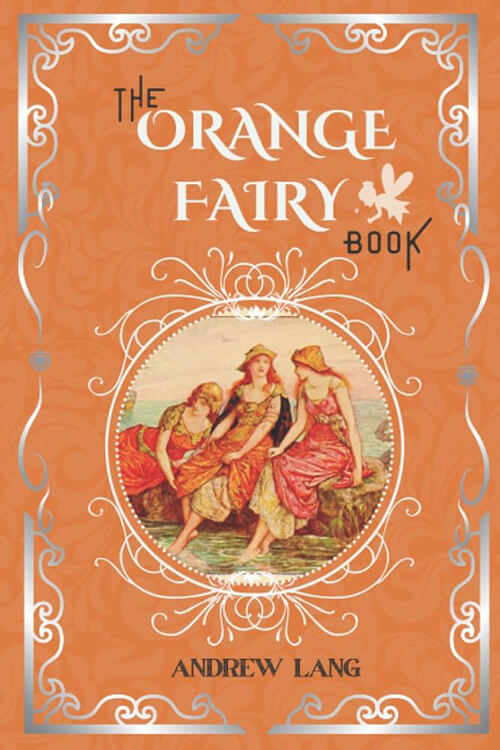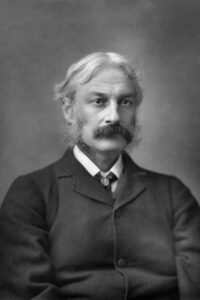
The Orange Fairy Book
Once upon a time, a child was born in the town of Senna on the banks of the Zambesi. He was not like other children, for he was very tall and strong. Over his shoulder, he carried a big sack and, in his hand, an iron hammer. He could also speak like a grown man, but he was usually very silent.
One day his mother said to him: ‘My child, by what name shall we know you?’
And he answered: ‘Call all the head men of Senna here to the river’s bank.’ And his mother called the head men of the town, and when they had come he led them down to a deep black pool in the river where all the fierce crocodiles lived.
‘O great men!’ he said, while they all listened, ‘which of you will leap into the pool and overcome the crocodiles?’ But no one would come forward. So he turned and sprang into the water and disappeared.
The people held their breath, for they thought: ‘Surely the boy is bewitched and throws away his life, for the crocodiles will eat him!’ Then suddenly the ground trembled, and the pool, heaving and swirling, became red with blood, and presently the boy rising to the surface swam on shore.
But he was no longer just a boy! He was stronger than any man and very tall and handsome, so that the people shouted with gladness when they saw him.
‘Now, O my people!’ he cried, waving his hand, ‘you know my name—I am Makoma, “the Greater”; for have I not slain the crocodiles into the pool where none would venture?’
Then he said to his mother: ‘Rest gently, my mother, for I go to make a home for myself and become a hero.’ Then, entering his hut he took Nu-endo, his iron hammer, and throwing the sack over his shoulder, he went away.
Makoma crossed the Zambesi, and for many moons he wandered towards the north and west until he came to a very hilly country where, one day, he met a huge giant making mountains.
‘Greeting,’ shouted Makoma, ‘you are you?’
‘I am Chi-eswa-mapiri, who makes the mountains,’ answered the giant; ‘and who are you?’
‘I am Makoma, which signifies “greater,”’ answered he.
‘Greater than who?’ asked the giant.
‘Greater than you!’ answered Makoma.
Read or download Book
Andrew Lang
Andrew Lang FBA (31 March 1844 – 20 July 1912) was a Scottish poet, novelist, literary critic, and contributor to the field of anthropology.
Biography.
He is best known as a collector of folk and fairy tales. The Andrew Lang lectures at the University of St Andrews are named after him Lang was born in 1844 in Selkirk, Scottish Borders. He was the eldest of the eight children born to John Lang, the town clerk of Selkirk, and his wife Jane Plenderleath Sellar, who was the daughter of Patrick Sellar, factor to the first Duke of Sutherland. On 17 April 1875, he married Leonora Blanche Alleyne, the youngest daughter of C. T. Alleyne of Clifton and Barbados. She was (or should have been) variously credited as the author, collaborator, or translator of Lang’s Color/Rainbow Fairy Books which he edited. He was educated at Selkirk Grammar School, Loretto School, and the Edinburgh Academy, as well as the University of St Andrews and Balliol College, Oxford, where he took a first class in the final classical schools in 1868, becoming a fellow and subsequently honorary fellow of Merton College. He soon made a reputation as one of the most able and versatile writers of the day as a journalist, poet, critic, and historian. He was a member of the Order of the White Rose, a Neo-Jacobite society that attracted many writers and artists in the 1890s and 1900s. In 1906, he was elected FBA.
He died of angina pectoris on 20 July 1912 at the Tor-na-Coille Hotel in Banchory, Banchory, survived by his wife. He was buried in the cathedral precincts at St Andrews, where a monument can be visited in the southeast corner of the 19th-century section. Lang’s writings on Scottish history are characterized by a scholarly care for detail, a piquant literary style, and a gift for disentangling complicated questions. The Mystery of Mary Stuart (1901) was a consideration of the fresh light thrown on Mary, Queen of Scots, by the Lennox manuscripts in the University Library, Cambridge, approving of her and criticizing her accusers. He also wrote monographs on The Portraits and Jewels of Mary Stuart (1906) and James VI and the Gowrie Mystery (1902). The somewhat unfavorable view of John Knox presented in his book John Knox and the Reformation (1905) aroused considerable controversy. He gave new information about the continental career of the Young Pretender in Pickle the Spy (1897), an account of Alastair Ruadh MacDonnell, whom he identified with Pickle, a notorious Hanoverian spy. This was followed by The Companions of Pickle (1898) and a monograph on Prince Charles Edward (1900). In 1900 he began a History of Scotland from the Roman Occupation (1900). The Valet’s Tragedy (1903), which takes its title from an essay on Dumas’s Man in the Iron Mask, collects twelve papers on historical mysteries, and A Monk of Fife (1896) is a fictitious narrative purporting to be written by a young Scot in France in 1429–1431.






